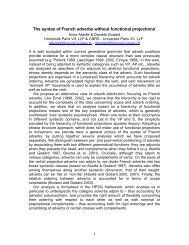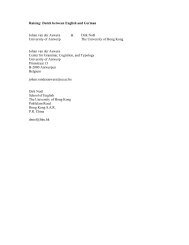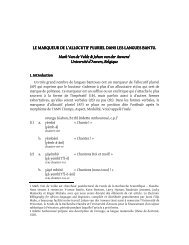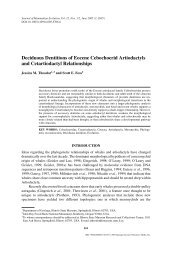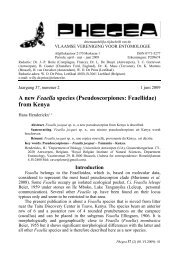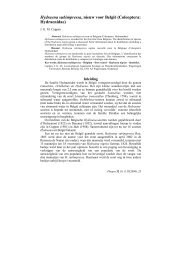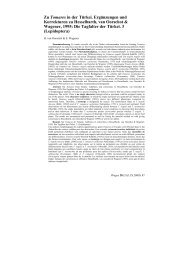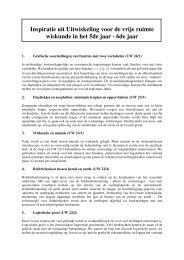Turtles as hopeful monsters
Turtles as hopeful monsters
Turtles as hopeful monsters
Create successful ePaper yourself
Turn your PDF publications into a flip-book with our unique Google optimized e-Paper software.
What the papers say<br />
Figure 2. The carapace of a marine turtle (Caretta<br />
caretta) in ventral view, showing the close <strong>as</strong>sociation of<br />
the ribs with the costal plates.<br />
spreads from them through the dermis to form the neural<br />
plates.<br />
The unique pattern of development of the ribs at a level<br />
outside the shoulder blade is not the end of the story, however.<br />
The amniote vertebra is composed of two parts that originally<br />
develop independently, but most of the time fuse in the adult<br />
(Fig. 1B). One part is the centrum, which replaces the embryonic<br />
notochord. Above the centrum develops the neural arch,<br />
which together with the centrum forms the neural canal for the<br />
spinal cord. In turtles, the neural arches of the dorsal vertebrae<br />
shift forward by half a segment, carrying the ribs with them,<br />
again a unique condition in amniotes. (15) The neural arches of<br />
successive vertebrae consequently meet each other above<br />
the midpoint of the centrum, where<strong>as</strong> the ribs come to lie lateral<br />
to the no longer functional intervertebral joints. The myomeric<br />
and neuromeric segmentation is thus secondarily established<br />
in the dorsal region of turtles, (16) <strong>as</strong> w<strong>as</strong> already the c<strong>as</strong>e in<br />
Proganochelys. (9) The functional re<strong>as</strong>on for this anterior shift<br />
of the neural arches is not clear, other than that it may<br />
contribute to the mechanical strength of the carapace, <strong>as</strong> the<br />
neural plates come to alternate with the costal plates (Fig. 1A).<br />
The ossification of endoskeletal structures preformed in<br />
cartilage, such <strong>as</strong> the ribs, within the dermis poses special<br />
problems for the comparative anatomist. Three types of bone<br />
have cl<strong>as</strong>sically been recognized: dermal bone, which develops<br />
in the dermis and typically characterizes the exoskeleton,<br />
chondral bone, which replaces cartilage during ossification of<br />
the endoskeleton, and membrane bone, which ossifies in deep<br />
laying membranes <strong>as</strong> part of the endoskeleton without<br />
cartilaginous preformation. The costal and neural plates of<br />
the turtle carapace start to develop <strong>as</strong> perichondral bone, <strong>as</strong> is<br />
typical for the initial ph<strong>as</strong>e of ossification of endoskeletal<br />
elements. But this perichondral bone develops in the dermis,<br />
and from it trabecular bone spreads through the dermis during<br />
BioEssays 23.11 989



